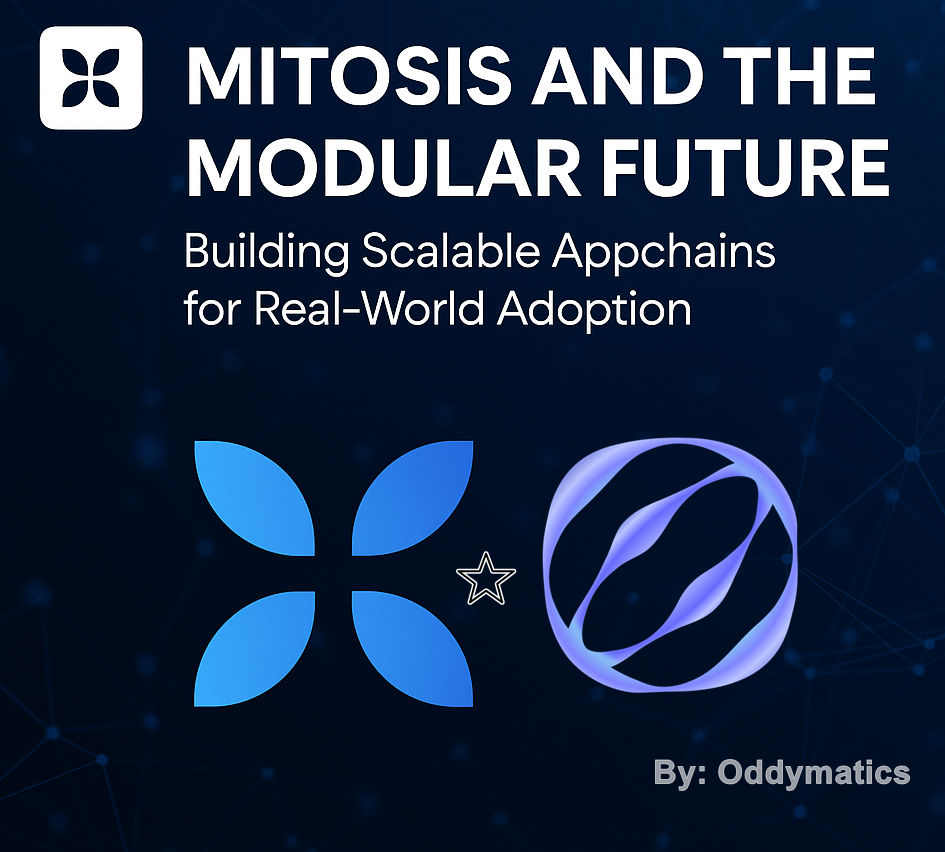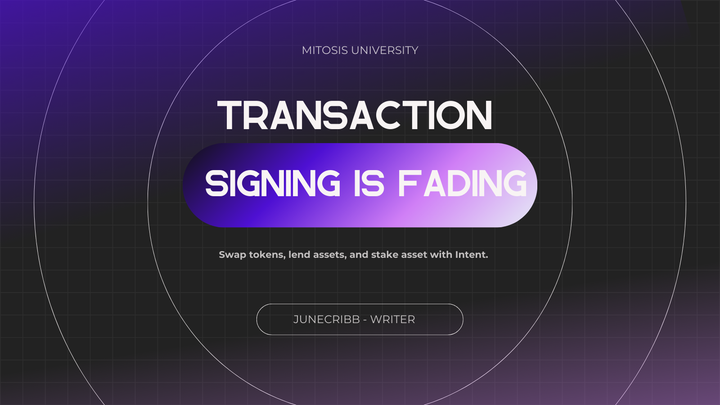Mitosis and the Modular Future: Building Scalable Appchains for Real-World Adoption

In the evolving world of blockchain infrastructure, modularity is emerging as a central theme in the race toward scalability, flexibility, and real-world application. Among the projects pushing this vision forward is Mitosis, a high-performance Layer-2 interoperability protocol that empowers developers to build scalable and interoperable appchains, application-specific blockchains tailored for precise functionality. As the industry shifts from monolithic chains to modular frameworks, Mitosis positions itself at the core of this transformation, offering the tools and architecture necessary to bring Web3 to the next billion users. The Modular Stack Breakdown:
- Execution Layer: Where transactions are processed (appchains, rollups)
- Settlement Layer: Where transactions are finalized (base chains like Ethereum)
- Consensus Layer: Where network agreement is reached
- Data Availability Layer: Where transaction data is stored
The Rise of Modular Blockchain Design
Traditional Layer-1 blockchains like Ethereum have long operated as monolithic systems, handling execution, consensus, data availability, and settlement in a tightly coupled stack. While robust, these chains often struggle with scalability and general-purpose performance, leading to congestion and high fees.
Modular blockchain design changes that paradigm by decoupling the blockchain stack into specialized layers. In this framework:
- Execution happens on flexible appchains
- Consensus is delegated to a shared network
- Data availability can be offloaded to optimized solutions
- Interoperability becomes native rather than bolted on
This shift allows developers to build lean, efficient chains that are optimized for their use case, whether that's high-frequency trading, gaming economies, decentralized identity, or on-chain AI agents.
Mitosis: Powering the Interchain Appchain Economy
Mitosis was born out of the growing need for a horizontal scaling solution that allows application-specific chains to thrive without sacrificing security or composability. It provides a permissionless environment where developers can spin up sovereign appchains while enjoying the benefits of shared infrastructure, such as:
- Shared Sequencer Layer: Ensures fast, decentralized ordering of transactions
- Zero-Knowledge Bridge (zkBridge): Enables instant, trustless interoperability across chains
- Liquidity Routing Layer: Facilitates deep, cross-chain liquidity for seamless DeFi
- Unified SDK & Dev Tooling: Streamlines the appchain development lifecycle
These features empower projects to move beyond the limitations of congested Layer-1s and build tailor-made environments for their communities and products.
Why Appchains? Real-World Benefits
Appchains, powered by Mitosis, offer unique advantages over generalized smart contract platforms:
1. Customization: Appchains allow builders to optimize transaction throughput, gas models, permission layers, and governance structures to match their exact requirements.
Example: A decentralized game can implement instant micro-transactions with minimal latency, a custom economic model, and a governance system tailored to players.
2. Performance & Cost: Because each appchain operates independently, it avoids the resource contention common on Layer-1s, resulting in lower fees and higher throughput.
Example: A high-frequency decentralized exchange (DEX) wants to offer low-latency trading with minimal fees.
Option 1: Deploy on a Monolithic L1 (e.g., Ethereum Mainnet)
- Throughput: Limited by Ethereum’s ~15-30 TPS.
- Cost: High gas fees during congestion (e.g., 5−5−50 per swap).
- Contention: Competes with NFTs, DeFi, and other apps for block space, leading to unpredictable latency.
Option 2: Deploy as an Appchain via Mitosis (Custom Rollup/Appchain)
- Throughput: 1,000+ TPS (optimized for trading).
- Cost: Near-zero fees (~$0.01 per swap) since it doesn’t compete with other apps.
- No Contention: Dedicated blockspace means no network congestion from unrelated apps.
Result:
- Traders get faster execution and lower costs.
- The DEX can customize its chain for MEV resistance, order-book optimizations, or privacy features without being constrained by the L1.
Real-World Analogy:
- L1 (Ethereum/Solana) = Shared Highway, Congested, slow, expensive during rush hour.
- Appchain (Mitosis) = Dedicated Express Lane, Only your app’s traffic, predictable performance, and minimal fees.
This is why appchains are ideal for performance-sensitive use cases like gaming, DeFi, and enterprise applications.
3. Security Through Shared Infrastructure: Mitosis leverages a shared sequencer and zk-bridging technology to inherit security from the broader ecosystem while maintaining sovereignty at the appchain level.
Example: A blockchain-based game wants to run its own high-performance appchain but needs strong security guarantees without relying solely on its own validator set.
Option 1: Standalone Appchain (Traditional Approach)
- Security Model: Requires its own validator set (e.g., 50-100 nodes).
- Risks:
- If the game isn’t big enough, validators may be too few (centralization risk).
- Expensive to bootstrap and maintain security.
- Vulnerable to 51% attacks if adoption is low.
Option 2: Mitosis-Powered Appchain (Shared Security + Sovereignty)
Mitosis provides:
- Shared Sequencer Network
- Multiple appchains share a decentralized sequencer pool (instead of each appchain running its own).
- Prevents single-chain bottlenecks while maintaining censorship resistance.
- ZK-Bridging for Finality
- The game’s appchain periodically commits ZK-proofs to Ethereum (or another secure L1).
- Even if the appchain is attacked, users can recover funds via the L1 bridge.
- Economic Security via Restaking
- Validators from Ethereum or other chains can restake their assets to help secure Mitosis appchains.
- The game’s chain inherits security from a larger pool of staked capital.
Result:
- Stronger Security: The game’s appchain is backed by Ethereum’s economic security (via ZK-proofs) and a decentralized sequencer network.
- Lower Costs: No need to bootstrap 100+ independent validators.
- Sovereignty Maintained: The game still controls its own execution rules (gas fees, throughput, upgrades).
Real-World Analogy:
- Standalone Appchain = Small Bank with Its Own Guards → Expensive, risky if underfunded.
- Mitosis Appchain = Bank in a Secure Shared Vault (with Ethereum as the Fort Knox Backstop) → Cheaper, inherits strong security.
This model makes appchains viable even for smaller projects, as they don’t have to sacrifice security for scalability.
4. Interoperability Without Friction: Through the native zkBridge, Mitosis appchains can seamlessly interact with each other and external ecosystems like Ethereum, Cosmos, and Solana, ensuring fluid asset and data transfers.
Unlocking Real-World Use Cases
Mitosis’s modular architecture is well-suited for a range of industries that require scalable, customizable infrastructure:
- DeFi: Launch custom lending protocols, AMMs, or structured products with native cross-chain liquidity.
- Gaming: Power high-frequency, on-chain interactions without compromising user experience.
- Real Estate & Supply Chain: Enable compliance-sensitive, scalable platforms for asset tokenization and logistics.
- AI & Autonomous Agents: Build appchains with native support for real-time computation and ML model verification.
With support for privacy-preserving features and customizable logic, appchains built on Mitosis are tailored for the real economy, not just on-chain experiments.
Developer-Centric Innovation
Mitosis understands that widespread adoption starts with a great developer experience. It offers a composable SDK that simplifies:
- Chain deployment
- Smart contract writing in familiar languages like Solidity and Rust
- zkBridge integration
- Interchain messaging
- On-chain governance modules
By removing friction, Mitosis lowers the barrier to entry for builders, paving the way for an appchain explosion, similar to how mobile SDKs unlocked the smartphone app economy.
Security, Sovereignty, and Scale: One of the core challenges in modular blockchain systems is preserving security guarantees while enabling developer freedom. Mitosis addresses this through:
- Zero-knowledge proofs for cross-chain validation
- A robust sequencer set with decentralized fault-tolerance
- Customizable governance modules that allow DAOs to control their appchain’s logic
Each appchain maintains sovereignty, governing its own upgrades, economic parameters, and validator sets, while benefiting from the collective infrastructure of the Mitosis network.
Outlook: Scaling to the Next Billion Users
For Web3 to move beyond speculation and into real-world utility, scalability, cost-efficiency, and UX must be dramatically improved. Mitosis delivers these by enabling application-specific blockchains that:
- Scale independently but interact seamlessly
- Offer sub-second finality with low fees
- Are governed by the communities that use them
As major Web2 and enterprise players explore blockchain solutions, modular frameworks like Mitosis provide a flexible, future-proof foundation that aligns with real business needs.
Conclusion
The modular blockchain future is not just a theoretical concept — it's becoming a practical necessity. Mitosis stands at the forefront of this evolution by giving developers the power to build secure, high-performance appchains that can interoperate and scale.
By combining sovereignty, composability, and interoperability in a single framework, Mitosis may well become the keystone infrastructure layer for the interchain economy. Its vision of horizontal scalability, powered by customizable appchains and zero-knowledge bridging, could help usher in the next era of global blockchain adoption.



Comments ()